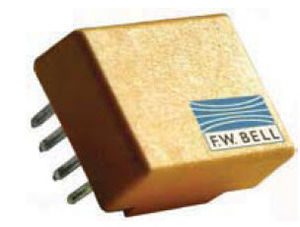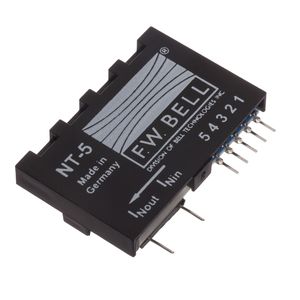
- Detection - Measurement
- Electrical Measurements
- Hall effect current sensor
- Sypris T&M - FW Bell
Closed-loop Hall effect current sensor for printed circuit boardsACDC


Add to favorites
Compare this product
Characteristics
- Technology
- closed-loop Hall effect
- Mounting
- for printed circuit boards
- Electrical characteristics
- AC, DC
Description
A closed loop current sensor consists of a Hall generator mounted in an air gap of a magnetic core, a coil wound around the core and a current amplifier.The current carrying conductor placed through the aperture of the sensor produces a magnetic field that is proportionate to the current. This field is concentrated by the core and sensed by the Hall generator. The Hall generator is connected to the input of the current amplifier, which drives the coil. The current through the coil produces an opposing field to that provided by the current through the aperture Thus the flux in the core is constantly driven to zero. The coil connects the output of the sensor. Therefore the output is a current proportional the aperture current multiplied by the number of turns on the coil. A sensor with a 1000 turn coil provides an output of 1mA per ampere. The current output is converted to a voltage by connecting a resistor to the output of the sensor and ground. The output of the sensor and ground. The output is scaled by selecting the resistor value. Closed loop sensors measure dc and ac currents and provide electrical isolation. They offer fast response, high linearity and low temperature drift. The current output of the closed loop sensor is relatively immune to electrical noise. They are the sensor of choice when high accuracy is essential.
Catalogs
No catalogs are available for this product.
See all of Sypris T&M - FW Bell‘s catalogsRelated Searches
*Prices are pre-tax. They exclude delivery charges and customs duties and do not include additional charges for installation or activation options. Prices are indicative only and may vary by country, with changes to the cost of raw materials and exchange rates.





